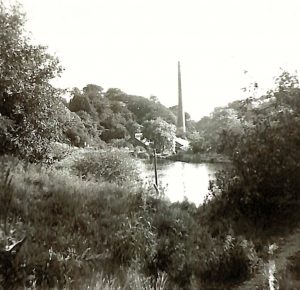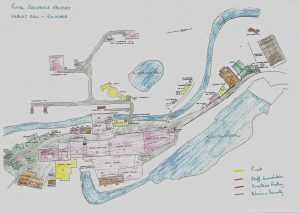Site of Biological Importance and Local Nature Reserve.
This Site of Biological Importance and Local Nature Reserve forms an attractive area of dense natural woodland on steep banks around the River Spodden valley. The Dell is a popular local visitor attraction due to the quality of the scenery (which includes spectacular waterfalls), its biodiversity (which includes a varied bird population and a resident population of Roe deer) and its industrial archaeology (the area contained water powered ancient corn, wool and cotton mills). A disused 1800s railway line is now a nature trail with magnificent views from a 100-foot high viaduct. There are extensive areas of woodland protected by Tree Preservation Areas (TPO’s).
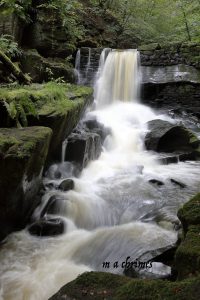
Healey Hall Mill

1985 Observer Article by John Cole
We are grateful to Bernice Clifton for providing the following photographs of the mill and surrounding area.
Mill cottages – 1974 – Note “EWS” on the side of the cottage. We think EWS = Emergency Water Supply – Click HERE for more information.
Buildings opposite the mill – 1974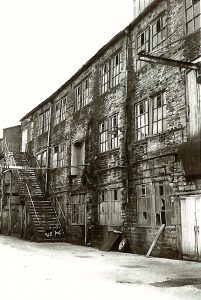
Mill lodged drained – Winter 1984-5
Lodge deepening – Jan / Feb 1987
Beginning to demolish the mill chimney – Feb 1987
Boundary stone in Smallshaw Wood – Spring 1985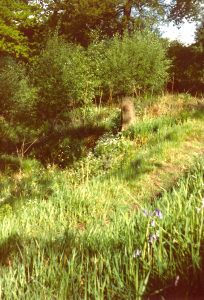
Packhorse bridge in Smallshaw Wood – Winter 1987
Healey Hall Munitions Filling Factory (1940’s)
During the Second World War an explosives Filling Factory was established at Healey Hall. It was designated as an assisted factory with guidance provided by the Royal Ordnance Factory at Chorley. Healey Hall filled 136 million 20-lb bombs for the RAF. For more detail see the Historic England Pastscape site and Lancashire At War.
Working in the Munitions Factory
Eunic Hutt, WW2 People’s War, Rochdale, Lancashire*
“I was 19 years old at the start of the war. I decided to work on the munitions rather than go into the forces. I was living in Lancashire, and I worked in a factory in Healey Dell near Rochdale, making Mortar bombs. We worked in a factory; it was like a big shed with all different rooms. We worked on an assembly line. We sat on either side of a long table and each did a bit of everything towards making the bomb. We changed places every shift so that the job didn’t become too monotonous. The explosives were put in at the very end. There was once an explosion but fortunately nobody was injured.
Healey Dell was a lovely place and the bombers couldn’t see the factory. When the bombers went over we just held our breath to see if they would drop a bomb. They didn’t and I’m still here to tell the tale! We sang a lot to the radio programme ‘music while you work’. We worked a fortnight on days and a fortnight on nights for £3.2.6d. I stayed all during the war and they wrapped up the firm after the war. I then went back to my old job working as a machinist in a clothing factory.”
*WW2 People’s War is an online archive of wartime memories contributed by members of the public and gathered by the BBC. The archive can be found at bbc.co.uk/ww2peopleswar
Maps of Healey Hall Munitions Filling Factory
The map below details: Plant, Staff Accommodation, Munitions Factory, Administration and Security
Below: Ministry of Supply Map
The following maps show the progression of the site from 1893 to the present day
Below: Ordnance Survey Lancashire Sheet LXXX. 16 Scale 1:2500 – 1893
Below: Ordnance Survey Lancashire Sheet LXXX. 16 Scale 1:2500 – 1910
Below: Ordnance Survey Lancashire Sheet LXXX. 16 Scale 1:2500 – 1929
Below: Ordnance Survey Landplan SD8714 Scale 1:5000 – 2003
Below: Remains of Healey Hall Munitions Filling Factory Nissen Huts (as detailed on the map above)
Video of Healey Hall Munitions Filling Factory
Production of Munitions in Rochdale During the Great War
Other Resource
The Dangerous Energy Project is an English Heritage (now Historic England) publication. There is a section on 2nd World War filling factories starting on page 211, which will give some general background information, and Healey Hall is listed in the gazetteer, at the end of the book, on page 279 (listed under Rochdale).
A Day In The Life Of A Munitions Worker – Imperial War Museum Great War Archive
Rochdale Observer 1975 – Healey Dell Mill Fire
Rochdale Observer 2005 – Healey Dell History


